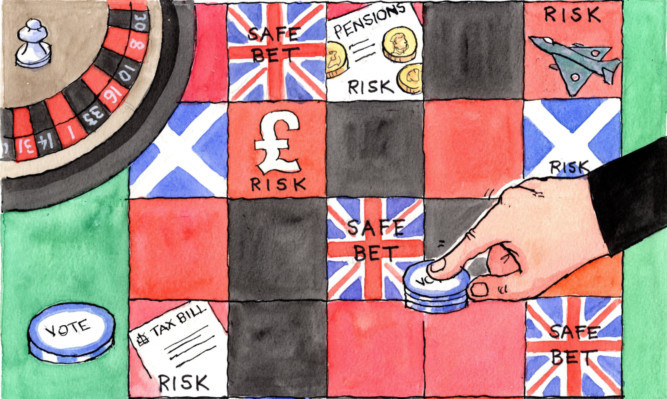
It has been the longest political campaign in this country’s proud history, with the final weeks providing a pulsating finish.
We are just five days from polling day and there is still no clear indication which way the vote will go. This places a heavy burden on those who have still to make up their minds on the big independence question.
Five months ago we launched our “referendum on trial” series with a simple question, who to trust?
It is a question which has become harder and harder to answer the longer the campaign has gone on.
The weight of our mailbag is testament to the fact that so many undecided voters have become lost with not just the bitter way the campaign has played out but also the starkly contrasting visions of our nation’s future under independence.
Time and time again readers have asked us, who is telling the truth?
Their frustration is understandable. This has been a political battle where the uncomfortable truths have been replaced by alternative truths, with even the opinions of neutral experts filleted so both pro and anti-independence camps can spin something from them.
Against this noisy backdrop, The Sunday Post has spent the past 20 weeks going through all of the big issues, week-by-week, and analysing them line-by-line to try and give our readers a better insight into what is really going on.
Our Independence On Trial guide to the key issues surrounding the referendum race pulls all of our analysis together using six key tests which the Post has identified as being crucial for the people of Scotland to make an informed, impartial and fair decision.
They are:
Can Scotland afford it?
Would Scotland be a fairer place to live?
Would you be better or worse off?
Would the Scottish economy benefit or suffer?
Would Scotland’s relationship with the rest of the UK and the world be better or worse off?
Would Scotland be a more or less secure place?
The difference between what is being promised and what is likely to be delivered is critical in a febrile atmosphere where voters are drowning in promises and warnings.
And that is why with each of these tests we have taken a view on the probability of what is being claimed coming to fruition.
The Sunday Post is not and will never be under obligation to any party or politician, our only duty is to our readers. Some may not like what we have printed in our referendum guide but we make no apologies for spelling out what we see as the considered facts around such a momentous decision.
There are hard truths to be found in many areas; the public sector pensions time bomb which both sides barely acknowledge exists, how the row over how much oil is left is actually irrelevant if the costs and complexities of getting it out of the ground keep increasing and how a currency union will still see interest rates set in London rather than Edinburgh.
These are all important points which people need to take time and digest before deciding which way to vote.
We also take a long hard look at the risks involved with everything from national security to people’s pensions. The cold reality is the risks with a yes vote are plentiful and no amount of spin can take away from this.
Independence is a gamble; we make no bones about saying that even if those in the Yes camp seem unwilling to acknowledge it. The pro-independence side has painted a picture that leaving the United Kingdom can be as simple as changing insurance providers but we can say with near certainty that it will not pan out like that.
There are of course risks associated with staying in the UK, the looming referendum on EU membership is one, but they are more quantifiable than the unknowns associated with a Yes vote.
This leads us to the elephant in the room of the whole referendum campaign, the negotiations. The Royal Mail, energy regulation, currency and splitting the assets are just some of the areas we identify in our analysis which could take years to sort out in the event of a Yes vote.
The version of independence on offer to voters through the White Paper could look very different years down the line when all of the wrangling was over.
It should also be noted the Yes camp will have us believe those with power in Westminster, portrayed for years as the villains, will suddenly become incredibly accommodating going into these negotiations.
The truth is those on the London side would then only be obliged to consider what suits the rest of the UK, meaning an independent Scotland which cannot walk away from these talks is in line for a tough ride at the negotiating table.
We are just days away from the referendum and there are so many areas where we don’t have, or it is impossible to have, definitive answers.
For undecided voters, this means where you put your X in the ballot paper will ultimately come down to who you feel you can trust.
Our job is to try to inform this decision with a sensible and critical look at the arguments that have been played out.

Enjoy the convenience of having The Sunday Post delivered as a digital ePaper straight to your smartphone, tablet or computer.
Subscribe for only £5.49 a month and enjoy all the benefits of the printed paper as a digital replica.
Subscribe